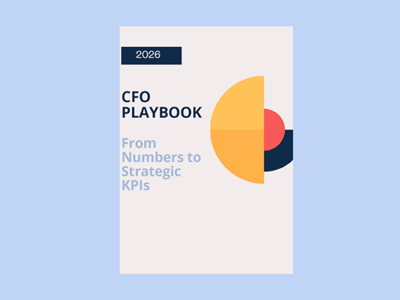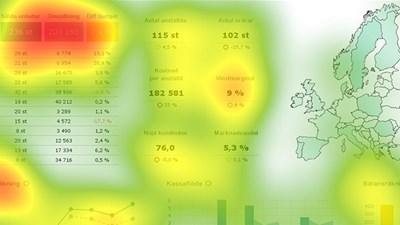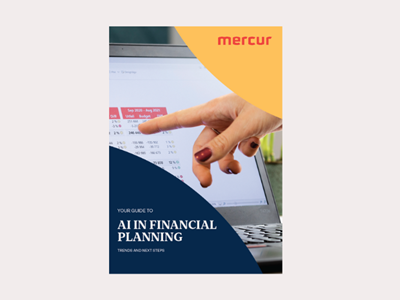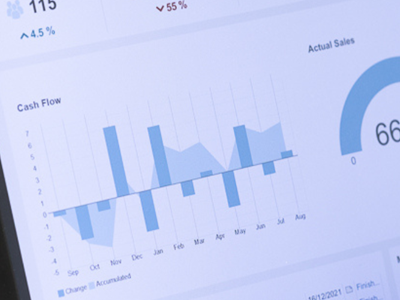.jpg?TS=638899726516314227)
The Powerhouse of EPM Tools: Discover Why Mercur Outshines the Competition
A business’s success heavily relies on having a strong strategy. However, what's even more important is implementing that strategy while tracking and measuring the performance. This can easily be done by investing in enterprise performance management (EPM) software. You can improve the financial processes of your company, streamlining operations and making faster, data-driven decisions.
EPM tools have evolved beyond simply financial planning and reporting. Today, they serve as central pillars for strategy, agility and growth while at the same time, integrating real-time data and analysis across your business functions. With so many solutions available on the market, how do you identify the truly exceptional one from the crowd?
Join us as we break things down to learn why Mercur Business Control is the platform that does it all.
EPM Tools and Their Importance
EPM tools are comprehensive software platforms designed to help businesses plan, monitor and analyse their strategies and operations in real time. The best EPM tools don't just automate budgeting but rather integrate data from every corner of your business. This will help to drive informed decision-making and adaptability.
These tools come with many important advantages, and here are some of them:
Powerful scenario planning and analytics
Increased organisational efficiency
Enhanced collaboration
Better visibility and accuracy
What Sets the Best EPM Tools Apart
With the market evolving, growing more competitive and more discerning, it may be difficult to choose the right tool. So, how do you distinguish between the best-in-class enterprise performance management solutions in a sea of capable contenders? Here are some tips on what to look for.
To create a seamless information flow and break down silos, EPM platforms aggregate data from ERP, SRM, HR and bespoke business systems. This ensures that you work with real-time, organisation-wide insights. In other words, no more wrangling with outdated spreadsheets and reconciling conflicting reports.
Some of the leading tools feature built-in workflow engines that automate repetitive tasks, approvals and notifications. Budget submissions and forecast revisions are complex processes that become traceable, streamlined and far less painful.
Modern EPM software isn't just about crunching numbers. It lets users visualise performance, KPIs, trends and forecasts in custom dashboards accessible to all and not just finance. Interactive analytics like drag-and-drop reports or scenario modelling make analysis accessible for everyone.
You can forge linear, siloed planning cycles. The best solutions empower cross-functional teams to contribute and comment in real time, aligning the entire business around shared goals.
High-ranking EPM tools provide ‘what if’ scenario capabilities as standard. It allows organisations to swiftly model the business impact of changes.
Great EPM solutions flex to your needs, regardless of whether you're a multinational organisation managing multiple entities and currencies or a focused SME. You should look for comprehensive configuration options rather than rigid modules. This allows you to adapt to changes in process and structure without the soft reengineering.
Various Benefits of EPM Tools
The landscape is set to keep changing. It's expected that more than half of the EPM software will come from cloud-based solutions. At the same time, in 2025, the EPM software market is expected to reach approximately US$5.53 billion. It is a shift that underscores the demand for high-accessibility, user-friendly and truly integrated performance management platforms.
However, EPM tools are not just about compliance and centralising data. They drive tangible results across every axis of business value.
Financial Benefits
Improved compliance: Automated financial close, audit trails and regulatory reporting mean fewer errors and reduced risk exposure.
Cost management and optimisation: Variance analysis and spend tracking make it easier to spot areas to cut costs or invest in growth.
Faster budgeting and forecasting: Automation shortens planning cycles, delivers more accurate budgets and enables rolling forecasts so finance can react to business in real time.
Operational Benefits
Real-time performance monitoring: Live dashboards and benchmarking empower agile management response to shifts in demand and performance.
Process efficiency: Automating manual, repetitive tasks frees skilled staff for value-adding work.
Bottleneck reduction: Clear workflow automation reveals and eliminates operational roadblocks, keeps projects moving and teams collaborating smoothly.
Strategic Benefits
Agility and resilience: Businesses using EPM are better equipped to handle market uncertainty, thanks to forward-looking, insight-led decision processes.
Unified decision-making: EPM provides a single source of truth, making it much easier to align departmental priorities and strategic objectives.
Scenario planning: Simulate hypothetical events like market changes and regulatory shifts, to make strategic pivots before the competitors even notice the trend.
Why Is Mercur the Ultimate All-in-One EPM Platform
Mercur Business Control stands out from the pack by addressing every modern business need in one unified, highly configurable solution. Here’s why Mercur deserves the top spot on your shortlist.
Comprehensive Functionality
Mercur offers a comprehensive set of tools to support your business needs. It enables detailed, versioned budget planning for areas like sales, production, projects and HR, all within a framework tailored to your processes. Instant dashboards and dynamic reports provide real-time insights across the organisation.
In addition, its advanced scenario analysis lets you model best-case and worst-case outcomes to stay prepared for any situation. The integrated workflow module tracks every task and stage, giving managers full visibility and helping employees prioritise effectively.
Cloud or On-Premise Flexibility
Depending on your business's demands, you can deploy Mercur in the cloud for instant scalability and mobile access, or opt for on-premise for total control.
Simple, Fast and User-Friendly
This EPM platform makes complex performance management easy for every user, from finance to operations to executive leadership. This is possible due to its clean dashboards, intuitive navigation and customisable interfaces.
Deep Integration and Single Source of Truth
Unlike many platforms built on disjointed modules, Mercur consolidates data from your ERP, sales, production and HR systems. This way, it creates a single version of the truth for faster, more reliable decision-making.
Customer-Focused Partnerships
Mercur is a trusted platform across industries that has built its reputation by listening to customer needs. This has led to delivering tailored implementations and supporting your journey every step of the way. Numerous vendors rely on us for decentralised P&L, branch management and global contact visibility.
Continuous Innovation
Built on decades of Scandinavian software expertise, Mercur provides regular updates that keep you ahead of industry best practices in automation, analytics and performance management.
Advanced Features for Modern Business
Businesses can use the numerous advanced functionalities of Mercur Business Control, such as:
KPI and scorecard tracking
Customisable conversions and multicompany support
Currency conversions and multicompany support
Workflow automation and audit trails
The Best EPM Tools to Unleash Your Organisation's Best
EPM tools have done away with slow, manual and fragmented business management. Today's leaders are developing a new narrative where timely insight, sharp strategy and seamless execution work hand in hand. You don't compete but set the pace when every department speaks the same financial language and where every forecast is an opportunity.
When it comes to performance management, playing it safe is the biggest risk. Therefore, choosing the best EPM solution gives you the confidence to make bold moves and the clarity to see exactly where they'll take you. Use the power of next-generation EPM and make it your organisation's not-so-secret weapon. Contact us today and make a personal demo request.
 Blog
BlogSave time and create a successful budget process
If you’re working in a large organization, you’re probably aware of how time-consuming the budget process can be. In this article we’ll give you tips on how to save time and still create a successful budget process
 Blog
BlogRolling Forecasts: Practical Steps, Benefits, and How to Get Started
Financial planning has changed. Traditional annual budgets can’t keep up with rapid shifts in the market, evolving customer needs, and internal performance dynamics. That’s why many finance teams are turning to a rolling forecast model.
 Blog
BlogZero-Based vs. Incremental Budgeting
Budgeting sits at the heart of sound financial management. This is why choosing the right technique is crucial for CFOs – it shapes resource allocation, cost control and strategic agility. Incremental and zero-based budgeting are two leading methods that offer distinct approaches.
 Blog
BlogAI in corporate budgeting
Artificial Intelligence (AI) can support decision making in key areas such as budgeting, capital allocation and even corporate strategy and as a result, it is increasingly being deployed in corporate performance management tools (CPM).
 Blog
BlogSpreadsheets are not Collaborative Tools
Spreadsheets were never designed for collaboration, yet they are the single most used program among teams and co-workers. They often start out as a quick document for storing, formatting or calculating information but evolve into important documents and are often the core records for an organisation.
 Blog
BlogWhy is our Excel-based budget always out of date?
Excel creates outdated budgets. Every time someone enters a figure, sends a file, or waits for another department to finish their section, your budget falls further behind reality.
 Blog
BlogCFO Playbook - KPIs for 2026
The role of the CFO is changing fast. Today, the finance function is expected to deliver more than reports — it must drive direction, speed and profitability through clear, actionable KPIs. Learn more in this guide.
 Blog
BlogSpreadsheets Risk the Future of the Business
Spreadsheets often start as just a list for storing information and there is minimal process documentation, support or maintenance for these worksheets. Despite the fact that desktop applications such as Microsoft Office are included in the standard configuration of users' PCs, very little formal training is ever given to spreadsheet users.
 Blog
BlogHow EPM Transforms Financial Planning and Forecasting
Struggling to keep plans aligned in a changing market? Discover how EPM helps finance teams move faster, stay accurate and lead with real-time insights.
 Blog
BlogHow do finance teams track KPIs across the entire organisation?
Learn how finance teams track KPIs across the entire organisation by consolidating data from multiple sources into a unified system like Mercur.
 Blog
BlogWhat Is Planning, Budgeting and Forecasting?
Planning, budgeting and forecasting are rarely static. Shifts in the industry often require you to revisit assumptions, adjust targets and adopt new processes. Learn how to strengthen your approach and stay ahead of change.
 Blog
BlogBoost Report Readability, Engagement, and Decision-Making
In today’s fast-paced business environment, effective reports and dashboards are crucial for decision-making. Our user study using eye-tracking technology revealed seven key insights into what captures attention.
 Blog
BlogThe Business Benefits of Integrated Business Planning
This blog explores what IBP is and the typical IBP process. We highlight business benefits and how the right software can be a game-changer for your organisation.
 Blog
BlogVariance Analysis: A Comprehensive Guide
Senior executives are demanding more detail in their management reports. The amount of data available to finance departments has exploded and decision makers see this as an opportunity to get more insight into how the business is performing.
 Blog
BlogHow To Create a Successful Budgeting Process
When done well, budgeting helps organisations stay financially on course, even when things don’t go exactly as planned. Learn how to keep things on track so you avoid surprises and stay focused on your goals.
 Blog
BlogTop PowerBI Alternatives in 2025
Explore the top PowerBI alternatives for 2025. Discover how Mercur delivers integrated planning, budgeting and reporting without the high cost and complexity.
 Blog
BlogBusiness Intelligence Reporting For Finance Teams
The real challenge today isn’t collecting data, it’s making sense of it and fast. Organisations turn to business intelligence (BI) to convert raw data into insight.But how do you actually do it right?
 Blog
BlogBuild Long-Range Planning for Business Success
Discover how effective long-range planning aligns strategy, finance and operations for smarter decisions and sustainable growth.
 Blog
BlogTop-Down vs Bottom-Up Budgeting
Budgeting aligns resources with strategic goals, and there are two primary approaches: top-down and bottom-up. Which method wroks best?
 Blog
BlogInformed Business Decisions at Maximum Velocity
The ability to process information swiftly is essential. If your business can’t manage your data efficiently, your company’s financial performance will surely underperform. At Mercur we have developed our own database Veloxic which helps Financial Planning and Analysis.
 Blog
BlogRisks with working in spreadsheets
Spreadsheets are an essential tool for all types of organisations and businesses rely on them heavily, particularly for financial computations. The most popular spreadsheet program globally is, of course, Microsoft Excel, it’s used by an estimated 750 million people.
 Blog
BlogAI in Financial Planning: Trends and Next Steps
Discover how finance teams are using AI to drive smarter planning, faster insights, and stronger business decisions.
 Blog
BlogBalancing Profitability and Sustainability
Sustainability has become a central concern for organisations across the world — and the UK is no exception. This evolving landscape places new demands on financial reporting.
 Blog
BlogTop 7 Manager KPIs for Financial and Operational Success
In today's post we'll break down why KPIs matter, which ones offer the most insight for finance and executive teams and how to ensure they're actually driving results.
 Blog
BlogBusiness Budgeting Software: How to Choose the Right One
Choosing budgeting software is partly a finance and partly a strategic decision. The right tool helps organisations organise planning cycles, adapt as the market changes and increase accountability across departments. But not every platform will be a good fit.
 Blog
BlogWhat is management reporting?
Management Reporting refers to the process of creating, analyzing, and presenting information about various aspects of an organization's performance to enable decision-makers to make well-informed decisions about the future.
 Blog
BlogManagement Reporting Guide: Definition and Tips
Management reporting helps you see what’s really happening in your business. In this guide, we’ll explain what managerial reporting looks like and share practical tips.
 Blog
BlogThe Hidden Cost of Data Silos
If you ever feel like your teams speak different languages when it comes to data, it is a classic symptom of data silos. The information gets stuck in one department, system or tool, making it difficult for anyone to see the full picture.
 Blog
BlogFive tips for a successful budget process!
How can you make your budget process more successful and maximise the effort that was invested in creating it? Of course, there are many factors to consider but we’ve chosen to highlight five key areas that will enable and help you create a smoother, value-creating and collaborative budget process.
 Blog
BlogA practcial guide to scenario planning
Scenario planning gives you a clear, practical way to test assumptions, spot risks and opportunities, and make better strategic choices so your organisation stays resilient when conditions change.
 Blog
BlogMastering Spreadsheets
Where many businesses start small, a simple spreadsheet can adequately perform the limited tasks required of it. As the company grows, your spreadsheets can get more complex and harder to manage, by which point it feels like it will be too difficult to move to a different reporting tool.
 Blog
BlogBetter Revenue Planning
Sales forecasting is the process of predicting future revenue based on past data and trends. Read the blog to learn the best methods to do it right.
 Blog
BlogHow can AI help CFOs make better decisions?
Artificial Intelligence (AI) has significant potential to enhance decision-making for Chief Financial Officers (CFOs) by providing data-driven insights, automating routine tasks, and enabling more accurate forecasts.
 Blog
BlogAI and Machine Learning, what is it, and why is it important for the future?
Artificial Intelligence and Machine Learning, what is it, and what is the difference?
 Blog
BlogCash Flow Forecasting
Inaccurate cash flow forecasting can be a costly mistake for companies. In today’s volatile market, relying on static annual budgets or manual spreadsheets leaves financial leaders without the agility to respond to uncertainty.
 Blog
BlogBudgeting in a modern world
Thirty years after its debut, Microsoft Excel is still the preferred tool for budgeting and planning projects. However, its popularity is declining, due in most part to the rise of technology and subscription-based pricing for a myriad of SaaS-based products.
 Blog
BlogSpreadsheet Risk Management: Best Practices for 2025
Excel has long been a target for hackers; just one click on a malicious attachment can infect your entire network. So, how can you keep using spreadsheets while not sacrificing your safety?
 Blog
BlogHow to get accurate financial reports without waiting for month-end
You don't need to wait until month-end to see accurate financial reports. With modern financial systems you can access up-to-date reports whenever you need them.
 Blog
Blog3‑Statement Model for Better Financial Forecasting
Financial forecasting is critical for any business that wants to adapt to change. But finance teams keep usingfragmented models and manual processes. The 3-statement financial model is the solution.
 Blog
BlogFP&A Trends Shaping Financial Planning in 2025
Many organisations cope with fragmented planning and data quality issues, which slow down their forecasting cycles. This forces organisations to take practical steps to turn ambition into execution.
 Blog
BlogWhat Is FP&A? Definition, Purpose, and Best Practices
Without solid financial planning and analysis (FP&A), businesses operate in the dark. In this post we go deeper into the process of FP&A and why it’s important for businesses.
 Blog
BlogBest Guide to Improve Your Revenue with Flexible Budgeting
Optimise your expenses with flexible budgeting, and learn how to adjust budget to reflect current business activities, market changes and cost fluctuations.
 Blog
BlogWhy xP&A is a powerful game-changer
The newest iteration of planning, analysis and reporting systems is a powerful game-changer that unites company departments and boosts competitiveness. It’s called xP&A – the abbreviation of extended financial planning and analysis.
 Blog
BlogHow Automated Reporting Will Transform FP&A in 2026
This article highlights the power of report automation, how to implement it in your business and explores any new opportunities for accurate financial analysis in the long run.
 Blog
BlogThe Role of the CFO: Top Priorities and Responsibilities
Today's finance leaders steer more than just budgets and reports. The digital transformation ramps up with the increase of corporate complexity, and so does the role of CFOs.
 Blog
BlogThe Collaborative, Smarter Budget
In many organisations manual budgeting processes over-burden staff and create masses of data which overwhelms department heads and stops them seeing the bigger picture.
 Blog
BlogFrom static budgets to agile financial management
Traditional budgeting has long been the cornerstone of financial planning in businesses. But today it can become more of a limitation than a strength. That’s where the concept of Beyond Budgeting comes in.
 Blog
BlogHow to Effectively Budget with Driver-Based Forecasting
Traditional models of forecasting rely on historical data and beliefs. It uses techniques that identify patterns, which are simple to use. However, with these methods, there are some challenges because they are not dynamic with today’s market, and can’t effectively analyse complex data.
 Blog
BlogScenario Planning - Better control during uncertain times
Uncertain times create the need for more frequent forecasts and time for analyzing and comparing different future scenarios. We give you 5 tips on how to simulate future scenarios using scenario planning
 Blog
BlogWhat is Corporate Performance Management? (CPM)
CPM, or Corporate Performance Management, is a process within corporate management aimed at measuring and optimizing the performance of an organization. CPM encompasses a range of activities, including budgeting, planning, forecasting, reporting, and analysis.
 Blog
BlogAI in Finance as a Powerful Tool
In this post, we explore how AI is evolving from a theoretical concept into a valuable resource for decision-making. Get useful insights for finance teams at any stage, from early exploration to actively using AI-powered solutions.
 Blog
BlogHow to succeed with your planning, budgeting, and forecasting process
We know it can be challenging to succeed with your planning, budgeting, and forecasting process. Therefore, we have gathered our best tips for you to succeed!



















































